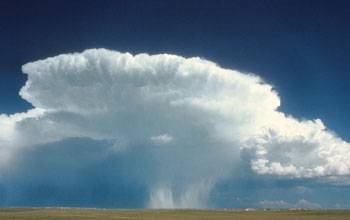
Ominous clouds signal a thunderstorm brewing on the U.S. Great Plains.
Credit: NOAA
Download the high-resolution JPG version of the image. (645 KB)
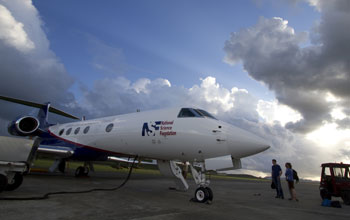
MPEX will include early-morning flights with the NSF/NCAR Gulfstream V aircraft.
Credit: UCAR
Download the high-resolution JPG version of the image. (8.7 MB)
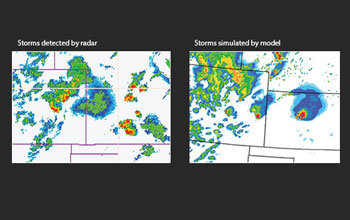
Even high-resolution models can't predict exactly where and when thunderstorms will form.
Credit: MPEX
Download the high-resolution JPG version of the image. (52 KB)
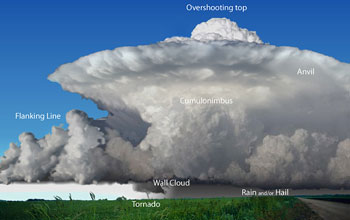
A supercell thunderstorm, "dissected" into its components.
Credit: NOAA
Download the high-resolution JPG version of the image. (79 KB)
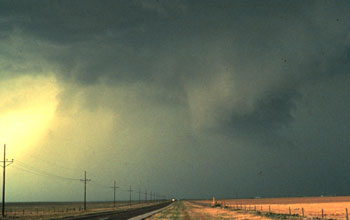
Day can turn into night very quickly when a thunderstorm strikes.
Credit: NOAA
Download the high-resolution JPG version of the image. (1.3 MB)

Lightning and thunderstorms go hand-in-hand, whether by day or night.
Credit: NOAA
Download the high-resolution JPG version of the image. (8 KB)
To better predict where and when spring thunderstorms rip across
Colorado's Front Range and the adjacent Great Plains, researchers are
launching a major field project this week with high-flying aircraft and
fine-grained computer simulations.
The month-long study could
point the way to major improvements in lead times for weather forecasts
during what has been called a crucial six- to 24-hour window.
"People
want to know whether there will be thunderstorms and when," says
National Center for Atmospheric Research (NCAR) scientist Morris
Weisman, one of four principal investigators on the project.
"We're
hoping to find out where you need to collect observations in order to
get the most improvement in short-term forecasts. Better prediction
with a few hours of lead time could make a big difference in helping
people prepare."
MPEX (pronounced "em-pex"), the Mesoscale
Predictability Experiment, runs from May 15 to June 15 and is funded by
the National Science Foundation (NSF).
The project includes
participants from NCAR; Colorado State University; the University at
Albany, State University of New York; Purdue University; the University
of Wisconsin-Milwaukee; and the National Oceanic and Atmospheric
Administration's National Severe Storms Laboratory.
"MPEX will
lead to a better understanding of the initiation and development of
severe storms in an area of the country that's particularly affected by
them," says Chungu Lu, program director in NSF's Division of Atmospheric
and Geospace Sciences.
"If we can move 'early warnings' even
sooner through the results of MPEX, it will lead to safer skies for air
travelers and safer situations on the ground as well."
The
project will include early morning flights with the NSF/NCAR Gulfstream V
aircraft to sample the pre-storm atmosphere across Colorado and nearby
states.
The Gulfstream V can cruise at 40,000 feet for up to six
hours, which will enable researchers to thoroughly canvass the entire
region where triggers for severe weather might be lurking.
MPEX
will also include afternoon launches of weather balloons carrying
instrument packages called radiosondes, which will profile conditions
around thunderstorms as they develop and move east across the Great
Plains.
Filling the same-day gap
Severe
weather warnings from the National Weather Service give people up to an
hour's notice for tornadoes and other threats on a county-by-county
basis. A key goal of MPEX is to help improve the forecasts that fall
between two types of longer-range alerts:
- convective outlooks, which highlight the risk of severe weather up to eight days in advance across large parts of the country;
- tornado and severe thunderstorm watches, which are issued up to eight hours in advance for state-sized areas.
Same-day
forecasts often note the likelihood of severe storms, but they do not
usually specify where and when the storms will develop.
MPEX will
help determine whether more detailed observations and simulations could
lead to more specific forecasts of storm location and behavior as much
as a day in advance.
Advanced forecast models can now simulate
the weather using data at points packed as closely as about a half-mile
from each other. This allows showers and thunderstorms (known as
"convection") to be explicitly depicted. But the newer models still
struggle to reliably map out storm behavior beyond about six hours in
advance.
Scientists believe this may be largely because the models
need more detail on upper-level features, such as pockets of strong
wind or dry air, located several miles above ground level.
As
these features move into the Great Plains, they can be critical for
triggering or suppressing severe storms. However, weather satellites may
not see these features, and they often go undetected by limited surface
and upper-air networks across the Rocky Mountain states.
"The
structure of the atmosphere two to six miles above sea level is
incredibly important," Weisman says. "This appears to be where the
biggest forecast errors develop, so we need to collect more data at
these heights."
In the sky and on the ground
To
get around the data roadblock, MPEX will send the Gulfstream V from its
base at the Rocky Mountain Metropolitan Airport in Broomfield on
missions that will start as early as 3 a.m.
The Gulfstream V will sample jet-stream winds, upper-level temperatures, and other features across Colorado and nearby states.
The aircraft will use a microwave-based temperature sensor to profile horizontal temperature contrasts miles above the region.
At
pre-specified locations, the Gulfstream V will also use parachute-borne
minisondes--compact instrument packages, similar to the 200-plus
radiosondes used every day across the nation--to gather extra detail
between flight level and ground level.
The minisondes will provide information on temperature, moisture, and winds four times each second.
"The
Gulfstream V is perfect for this kind of study," says NCAR project
manager Pavel Romashkin, who will oversee MPEX aircraft operations. "The
G-V is one of very few aircraft in weather research that can sample the
atmosphere near the top of important features for a number of hours."
MPEX
will also gather data with three radiosonde launch units operated by
Purdue and NSSL in vehicles that will maneuver around late-day
thunderstorms.
The goal is to find out how well the extra data
can help predict local and regional weather conditions into the next
day, as well as to assess how the thunderstorms interact with the
atmosphere that surrounds and supports them.
"We know that even
isolated, short-lived thunderstorms influence their environment," says
Robert "Jeff" Trapp of Purdue, an MPEX principal investigator.
"The
MPEX data will allow us to quantify these influences and examine how
well they are represented in computer forecast models. This information
can then be used to help improve weather forecasts."
Testing the value of enhanced observations
With
the help of improvements in computing power and scientific
understanding, forecast models can depict weather in far more detail
than just a few years ago.
On each day of operations (about 15 in
all during the project), MPEX will produce an ensemble of up to 30
forecasts using the NCAR-based research version of the multiagency
Weather Research and Forecasting model (WRF-ARW).
Along with data
from the Gulfstream V flights, each WRF-ARW ensemble member will use a
slightly different characterization of early-morning weather conditions
in order to allow for the uncertainty inherent in those measurements.
Forecasters can then issue forecasts with greater or lesser confidence based on how the ensemble forecasts agree or disagree.
The
MPEX team will also evaluate how much the Gulfstream V data improve
forecasts in two other modeling systems, both of which are updated each
hour.
The complex process of incorporating observed data into the
MPEX simulations will be handled by NCAR's Data Assimilation Research
Testbed.
Studies have shown that major forecast improvements are
possible when the right kinds of data are collected and assimilated into
forecast models.
Scientists hope the results from MPEX will
help advance this process, which could improve predictions of severe
thunderstorms as well as other types of high-impact weather where better
forecasts in the six- to 24-hour period could help people and
communities better prepare.
-NSF-
Media Contacts
Cheryl Dybas, NSF (703) 292-7734 cdybas@nsf.gov
David Hosansky, NCAR (303) 497-8611 hosansky@ucar.edu
David Hosansky, NCAR (303) 497-8611 hosansky@ucar.edu
Related WebsitesNSF Mesoscale Predictability Experiment (MPEX):
The National Science Foundation (NSF) is an independent federal
agency that supports fundamental research and education across all
fields of science and engineering. In fiscal year (FY) 2012, its budget
was $7.0 billion. NSF funds reach all 50 states through grants to nearly
2,000 colleges, universities and other institutions. Each year, NSF
receives about 50,000 competitive requests for funding, and makes about
11,500 new funding awards. NSF also awards about $593 million in
professional and service contracts yearly.
Useful NSF Web Sites:
NSF Home Page: http://www.nsf.gov
NSF News: http://www.nsf.gov/news/
For the News Media: http://www.nsf.gov/news/newsroom.jsp
Science and Engineering Statistics: http://www.nsf.gov/statistics/
Awards Searches: http://www.nsf.gov/awardsearch/
NSF Home Page: http://www.nsf.gov
NSF News: http://www.nsf.gov/news/
For the News Media: http://www.nsf.gov/news/newsroom.jsp
Science and Engineering Statistics: http://www.nsf.gov/statistics/
Awards Searches: http://www.nsf.gov/awardsearch/
The National Science Foundation (NSF).
Guillermo Gonzalo Sánchez Achutegui
ayabaca@gmail.com
ayabaca@hotmail.com
ayabaca@yahoo.com
Inscríbete en el Foro del blog y participa : A Vuelo De Un Quinde - El Foro!

No hay comentarios:
Publicar un comentario